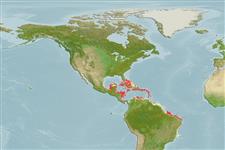>
Gobiiformes (Gobies) >
Gobiidae (Gobies) > Gobiinae
Eponymy: Isaac Ginsburg (1886–1975) was a Lithuanian-born goby taxonomist at the US National Museum and for the US Fish & Wildlife Service. [...] (Ref. 128868), visit book page.
More on author: Fowler.
Environment: milieu / climate zone / depth range / distribution range
Ecologia
marino associati a barriera corallina. Tropical; 27°N -
Western Central Atlantic: The Bahamas, Cayman Islands, and Antilles south to Venezuela and Colombia (Ref. 092840).
Size / Peso / Age
Maturity: Lm ? range ? - ? cm
Max length : 2.5 cm TL maschio/sesso non determinato; (Ref. 7251)
Spine dorsali (totale) : 7; Raggi dorsali molli (totale) : 12; Spine anali: 0; Raggi anali molli: 10. Distinguished by having the following characteristics: dark brown body with nine, bright blue, thin, vertical lines; presence of rostral frenum (Ref. 92840).
Inhabits shallow areas with clear water and coral formations (Ref. 13628), often in close association with the sea urchin Echinometra lucunter. Possesses a ventral sucking disk which allows it to adhere to the rock beneath the test of an urchin with only the head showing among the spines of urchins. When disturbed they retreat farther beneath the urchin, and if the urchin is removed it rapidly darts beneath the test of a neighboring one. Feeds mainly on the tube feet of sea urchins (Ref. 33548)..
Life cycle and mating behavior
Maturità | Riproduzione | Deposizione | Uova | Fecundity | Larve
Robins, C.R. and G.C. Ray, 1986. A field guide to Atlantic coast fishes of North America. Houghton Mifflin Company, Boston, U.S.A. 354 p. (Ref. 7251)
IUCN Red List Status (Ref. 130435: Version 2024-1)
Threat to humans
Harmless
Human uses
Pesca: commerciale; Acquario: Commerciale
Strumenti
Special reports
Download XML
Fonti Internet
Estimates based on models
Preferred temperature (Ref.
123201): 26.7 - 28.2, mean 27.5 °C (based on 600 cells).
Phylogenetic diversity index (Ref.
82804): PD
50 = 1.0000 [Uniqueness, from 0.5 = low to 2.0 = high].
Bayesian length-weight: a=0.01023 (0.00477 - 0.02194), b=3.01 (2.83 - 3.19), in cm total length, based on LWR estimates for this (Sub)family-body shape (Ref.
93245).
Trophic level (Ref.
69278): 3.0 ±0.00 se; based on food items.
Resilienza (Ref.
120179): Alto, tempo minimo di raddoppiamento della popolazione meno di 15 mesi (Preliminary K or Fecundity.).
Fishing Vulnerability (Ref.
59153): Low vulnerability (10 of 100).
Nutrients (Ref.
124155): Calcium = 383 [168, 1,323] mg/100g; Iron = 1.93 [0.82, 4.27] mg/100g; Protein = 18 [16, 20] %; Omega3 = 0.17 [0.05, 0.54] g/100g; Selenium = 40.1 [11.9, 113.9] μg/100g; VitaminA = 90.2 [17.0, 456.9] μg/100g; Zinc = 4.8 [2.6, 8.0] mg/100g (wet weight);
